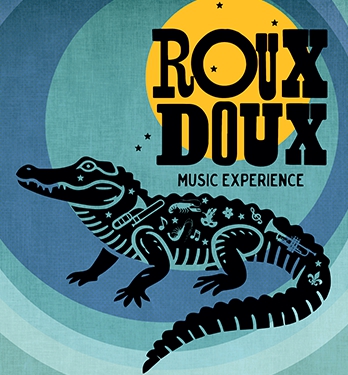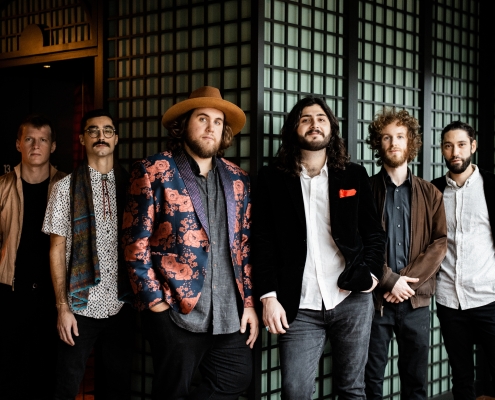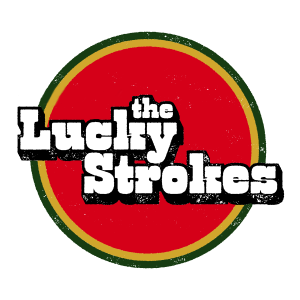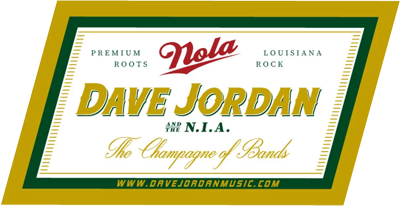ROUXDOUX FESTIVAL LINEUP
Festival Performers November 23, 2024

Festival Performers November 23, 2024
 At the core of soul music is a vibrant, embracing spirit, one aimed at connecting the dots of humanity that reside on both sides of the microphone.
At the core of soul music is a vibrant, embracing spirit, one aimed at connecting the dots of humanity that reside on both sides of the microphone.
“It doesn’t matter if there are 10 people in the audience or a 1,000,” says Jordan Anderson, lead singer/keyboardist for J & The Causeways. “It’s that sacrifice we make of our art, so that people can feel it that much harder the first time they hear you.”
In a serendipitous sequence of events, J & The Causeways was formed at the legendary Maple Leaf Bar in New Orleans. A juggernaut soul/R&B ensemble, the group is filled with heavy backbeats and a soaring horn section, all swirling around the magnetic vocal stylings of Anderson.
“We definitely shine live because each and every member of this band loves to be onstage and in that genuine moment of performance,” Anderson says. “New Orleans is home to some of the finest singers and musicians on the planet, which also means you have to bring your A-game to every single show — you’re representing this city and the long history of beautiful music that’s been created here.”
As a kid, Anderson was first exposed to the power of music from his grandmother, a piano teacher in his small rural Louisiana hometown. It was her backroom record collection that mesmerized Anderson, where he found himself thumbing through the vinyl and discovering the likes of Otis Redding, Al Green, Queen, and Aretha Franklin.
“I learned early on to not fall into the vanilla variety of pitch,” Anderson says. “It’s about finding a certain power that you can harness with the pure emotion of your voice, which is what all of those singers had — finding that spectrum of vocalists who put it all out there for the audience.”
With J & The Causeways, Anderson is fronting a band that finds itself mentioned in the same breath as the likes of St. Paul & The Broken Bones, Nathaniel Rateliff & The Night Sweats, and The Marcus King Band — all modern-day entities of passion and purpose, each summoning the pulsating, endless energy of soul/R&B music.
“With soul music, it’s those live moments where you feel truly elevated, and you’re bringing the audience along with you to that higher place,” Anderson says. “And you’re creating this space of inclusivity and connectivity — there’s no way you’re leaving that stage without a smile on your face.”
For J & The Causeways, it’s about bringing forth a communal sense of self within the greater universe of knowns and unknowns — we’re all in this together, so let’s share in the depths of our raw, honest emotions through the sound and spectacle that is live music.
“I like to help people find joy. And I find that a lot of people just don’t know how to be vulnerable enough to find that joy,” Anderson says. “I want our music to help unlock that beauty that resides within each of us, to let out that vulnerability of what it means to be in the presence of live music, and of each other — music has always lifted me up, and I want to lift up the listener every single time I’m on that stage.”


If luck is what happens when hard work meets opportunity, the union of Eddie Roberts & The Lucky Strokes epitomizes that adage. The New Mastersounds’ guitarist and bandleader has a knack for leaning into individual strengths and that sensibility is evidenced through his recruitment of Mississippi-based
guitarist and vocalist, Shelby Kemp, who brings a Southern rock grit and candid, nimble songwriting to team up with the Tampa Bay-based Galbraith sisters who possess a simpatico rhythm section chemistry only found within a family bloodline.
Powered by the urbane guitar playing and production of Roberts and you have a new tour de force ensemble that makes listeners stop in their tracks the same way Roberts did upon hearing the talents of Kemp and the Galbraith Sisters.
The quartet first teamed up to perform Cervantes’ Masterpiece Ballroom’s 20th Anniversary party in Denver, CO, and recorded a full-length record at Color Red Studios the next day to further solidify the newly forged musical connection. The sound is an amalgamation of celebrated country lyricists such as Willie Nelson, Waylon Jennings, and George Jones mixed with the rhythmically driven aesthetics of James Brown and rounded out by honest rock ‘n’ roll—a combination slated to make its own luck and take the scene by storm.

A nearly 3 decade staple of the New Orleans and south Louisiana music scene, Dave has been described as a swampy lovechild of Tom Petty, John Prine and Dr. John and “the personification of the New Orleans ethos”.
A 3 time finalist in offBeat magazine’s Best of the Beat awards for Best Roots Rock Band and Best Roots Rock album, he’s been lauded as “one of New Orleans’ great songsmiths and bandleaders of my generation” by musician and long time WWOZ DJ Marc Stone.
He regularly performs at New Orleans institutions Tipitina’s, the Maple Leaf and DBA, as well as every major festival in south Louisiana, including multiple performances at the iconic New Orleans Jazz and Heritage Festival. He has recorded with New Orleans legends Art Neville, George Porter, Anders Osborne and more, and has released 5 albums since 2010, including These Old Boots, which was named Top 10 of the Year by NOLA.com/Times Picayune.
As a national touring act, he frequently performs in the southeast, Colorado and the mountain west, and throughout Florida to Key West. He has been featured in various national media outlets including Relix, Paste, Hittin’ The Note and NPR. Over the course of his career, he has shared the stage with legendary artists Widespread Panic, Little Feat, funky Meters, Col. Bruce Hampton, Aquarium Rescue Unit, Merl Saunders, Galactic, drivin’ n cryin’, Leftover Salmon and more. In fall of 2022 he will make his debut at the prestigious Telluride Blues and Brews Festival.
For his latest release, Keep Going, Dave has once again teamed up with Anders Osborne. For their third album collaboration, Osborne not only produces, but also provides his extraordinary guitar work with a backing band that includes legendary bassist George Porter, Jr (The Meters); renowned studio and touring drummer Chad Cromwell (Neil Young/Mark Knopfler); and local violinist and frequent bandmate, Rurik Nunan (Cracker/Loose Cattle). Featuring nine tracks, the album highlights Jordan’s potent blend of Americana storytelling and south Louisiana roots music.

Royal Horses is a Hattiesburg, Mississippi based rock band formed by Shelby Kemp and Daniel Firth. The band got its start in 2016 playing shows around South Mississippi and has been steadily expanding their touring range in the years since. The now five piece band has played in venues from Virginia to Colorado and all around the Southeastern United States. The band released their debut album in 2020, A Modern Man’s Way To Improve, and toured on the back of that album following the pandemic. In 2022 the band released their second record, Where The Purple Flowers Grow, on Eddie Robert’s Denver based record label, Color Red Music.
The Royal Horses of today has gone through a few lineup changes, with 2022 seeing the addition of Scott Chism on bass guitar, and 2023 bringing the addition of Brandon Kenyon on the trumpet and Lynsey Terry on vocals. Combine that with the powerhouse drumming of Daniel Firth, and the guitar slinging, singing and songwriting of Shelby Kemp, and you get the most powerful, mature, and musically diverse version of Royal Horses ever.
The song featured in the video above, The Spirits That Move Me, is one great example of the bands dynamic sound- featuring tight vocal harmonies and carefully executed melodies on both the trumpet and guitar, which blend in, out, and all around the driving rhythm section that holds the whole thing firmly in place. In live settings, the guitar and the trumpet often take off together in lock step for harmonized solos and interchanges that will knock you off your feet, only to set you back down gently on a sweet bed of three part harmony that will soothe the spirit and excite the ears.